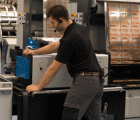With this feature, plates mounted in the internal drum can be punched after exposure in the same location, thereby guaranteeing one-hundred-per-cent registration of all the colours in the printing press.
Above all, says Lüscher, the XPose! imagers employed in fully-automatic-plate production, which are now much in demand, depend upon such a register punch in order to avoid expensive multiple supplementary punching.
Manual punching in semi-automatic production
The great advantage of the XPose! thermalplate imager is its open internal drum which enables the operator to load the plates, and remove them, by hand. Usually the operator first punches the plate in an external punch and then either places it in the imager or hangs it on the register pins in the exposure trough. That is relatively accurate but still allows for slewing of the plates due to the human factor.
Automatic punching after the developing stage
Fully-automatic-functioning CtP processing lines generally employ automatic punches after the developer and before the rubbering stages for punching in register. To do that, a CCD camera locates the register crosses or marks on the plate and angles each plate before the register holes are punched in the plates. Such mechanisms are technically complex, start at a price level of €100000 and become considerably more expensive with the addition of each extra-required register system.
Certainly such a system calls for plates with high colour contrasts. Additionally, the prior rubbering function irritates the optical sensors, prompting the need for additional rubbering after punching.
Automatic punching after imaging
On the other hand, the new register punch from Lüscher is technically much simpler. The plates are placed – either manually or by the Plate Handling System – in the bed of the imager; fingers pressing from both sides then centre the plates on the bed after which grippers pull the plate on to the front alignment of the imager. These two procedures are repeated again and again in order to guarantee accurate plate positioning. Only then is the plate held fast by a vacuum. Following that, the plate is exposed after which the two punching tools move to the front edge of the plate and punch either the front holes or round holes of the required system. Only then is the vacuum switched off and the plate removed from the imager.
A variety of systems on offer
The punch system can only be installed in newly-ordered machines. In addition to the Bacher 2000 punch, which is most in demand for the majority of sheet-fed offset presses, other punch systems can be integrated in an imager. Selling at a basic price of €16500 (and €6700 for each additional punch system), the system is considerably cheaper than those installed after the developer unit.
Enlarging on that point, Lüscher marketing director, Lars B. Janneryd adds: “Of the 680 XPose! imagers delivered world-wide, more than 120 were sold with Plate Handling Systems. With the development of our inline punch we want to help the printers save on the cost of expensive punch systems after the developer unit.”
Good experience in practice
The first XPose! 130 with Plate Handling System (PHS 130) and inline punching was delivered at the beginning of January 2005 to the jobbing printer Kromer Print AG in Lenzburg, Switzerland, where it replaced a four-year-old Xpose! imager.
The company’s managing director, Andy Amrein, is convinced that he took the right step: “We operate six different types of offset presses with 21 printing units and since 2001 have been punching the plates normally. The new XPose! 130 with the Plate Handling System greatly relieved staffing requirements in our plate production department because we imaged 7055 plates in the first three months! And we have noted that colour register has become more consistent because inline punching eliminates the human-error factor. Previously, despite manual punching, time and again we had to angle the plates correctly on the press; that no longer happens with inline punching.”
Immediate availability
Every XPose! imager in the 130, 160, 180 and 190 format range can be delivered immediately, with the integrated inline punching facility, within the normal delivery time.
Comment below to have your say on this story.
If you have a news story or tip-off, get in touch at editorial@sprinter.com.au.
Sign up to the Sprinter newsletter

